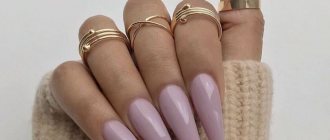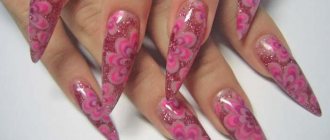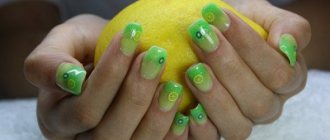Nail extensions are a procedure that allows you to get beautiful, long nails. This is especially convenient for girls with short and brittle nails. Proper nail extensions allow you to get a beautiful manicure, even if the procedure is carried out independently, at home.
Form extensions
There are two types of extensions: forms and tips.
The first option is preferable, since the nails turn out thin and natural in appearance. To perform the procedure, you will need special forms, which are stencils with markings and a window. They are disposable, made of flexible plastic or paper, and reusable, made of thick plastic and metal.
The advantage of this method is its versatility - gel nail extensions at home can be done for nails of any shape. It’s easy to select a stencil, so there are no difficulties with the procedure at the stage of purchasing materials.
The markings on the stencil help you choose the length of the free edge that will be most comfortable. After the material hardens, the form is removed, which makes the nails thin.
Minuses
Before you extend your nails with acrylic, you need to know about some of the disadvantages that this material has. Video lessons on acrylic nail extensions for beginners will help you learn that a material such as acrylic is toxic and has an unpleasant odor.
As you can see in the photo, the starting materials you will need are: acrylic itself, a liquid that increases the adhesion of the artificial nail to the natural one, a nail file, a brush, a degreaser and a solvent. You can buy this at any specialty store. The purchased materials will last you for a long time, so the money spent can pay for itself extremely quickly.
How to do gel nail extensions: step-by-step instructions
What you need for nail extensions:
- antiseptic for hand disinfection;
- cuticle softener;
- an orange stick to push back the cuticle;
- manicure scissors, tweezers;
- files and buffs for leveling the nail plate and processing the free edge;
- primer for better adhesion of the nail to the material;
- base and top;
- forms;
- modeling gel for creating nails;
- gel polish for design;
- lamp.
Please note that the gel used for modeling is cured only in UV lamps, so equipment marked LED is not suitable.
Step-by-step nail extensions using forms.
- You need to start working with disinfecting your hands and nails. This is important to prevent infection in wounds in case of a cuticle or finger cut. Instruments are sterilized before use.
- Perform a hygienic manicure by removing the cuticle and pterygium. To make the cuticle easier to remove from your fingers, you should first soften it and push it away with an orange stick. Remove overgrown cuticles carefully, especially if you haven't had your nails done for a long time.
- The smooth layer is removed from the surface of the nail plate using a nail file. The nail should be handled carefully, without putting too much pressure on the finger. Nail dust is removed using a special brush.
- Nails are degreased with a dehydrator. Next, a primer is applied for better adhesion of the material to the surface of the nail.
- The base is applied to the prepared base. Before extensions, you need to apply the base in a very thin layer, then dry it under a lamp for 2-3 minutes.
- The most important stage is installing the form. Beginners are recommended to use solid stencils: they fit easily, you just need to choose the right size. If the shape is too soft, you can combine two stencils. The form is laid carefully, arches are created.
The next stage of gel nail extension for beginners is the formation of an artificial nail. To do this, a modeling edge is applied over the form.
First, the nail is visually divided into three parts. After this, the material is applied according to the scheme.
Base layer.
The material is applied to the area near the cuticle, brought to the stress zone (where when you press on the tip of the nail, the plate turns white). The layer is dried under the lamp for 30 seconds.
Base layer.
In the stress zone, the material thickens and goes down towards the form. The gel is applied thickly to the stencil. If necessary, the thickness is adjusted with a nail file. Next, the layer is dried under a lamp for 3 minutes.
The final layer.
At the final stage, a thin layer of gel is applied to the free edge. Dries in 2-3 minutes.
The next stage is giving the nails the desired shape and length. To do this, first remove the sticky layer, and then file all the nails. Next, camouflage varnish is applied and a design is made as needed. Each layer of varnish is dried in a lamp for at least 60 seconds.
The self-manicure is completed by covering the top and removing the sticky layer.
Care for extended nails
Extended nails require special care. Shortly before the procedure, it is necessary to abandon certain beauty rituals.
Care before extensions
Before getting your nails done, avoid hand cream and do not apply oil to the cuticle area. These products prevent the nail plate from adhering to the coating.
Care after extensions
It is not recommended to visit the bathhouse or sauna within 24 hours after extensions. The nails are not yet strong and temperature changes can damage the coating. It is better to wash the posulu with gloves, this will prolong the glossy effect of the coating.
How to do nail extensions with tips
Tips are plastic forms that imitate a nail. They are glued to your nail and then covered with gel. This method of extension is easier, but we have to spend a lot of time on tips of the right size, especially for non-standard fingers.
Another disadvantage of this type of extension is the creation of thick nails. With this type of extension, a multi-layer designer coating is not applied, since it thickens the nail even more.
How to properly do nail extensions using tips.
- First you need to choose the tips. They should fit the nail as wide as possible. If you cannot choose, then it is better to choose a shape wider than the plate, since it can be filed and adjusted to the width of the nail.
- Nails are prepared for extensions: the cuticle is trimmed and the smooth layer is removed from the plate. The free edge is cut off, about 0.5 mm should remain.
- Glue is applied to the tips up to the step, which is applied to the edge of the nail. The tip is glued to the nail and pressed. It is important to pay attention to the line of the step - it should coincide with the edge of the nail.
- The excess length is removed with a tip cutter, then the desired shape is given with a file. Next, the surface of the artificial nail is slightly filed down for better adhesion to the material.
- A layer of gel is applied. The layer should be thin from the cuticle, thick in the middle of the nail. Make sure that the layer of material is not too thick, otherwise the gel may not harden.
- After the gel has dried, the sticky layer is removed. The procedure is completed by applying and drying camouflage varnish.
For beginners, it’s more convenient to get a beautiful manicure with tips. But they thicken the nail, preventing the excess layer from being removed. It’s different with forms - they are removed after the gel hardens and are no longer needed, so they are removed from the nail and thrown away.
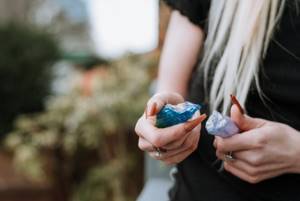
Building and strengthening with biogel
Biogel is a type of regular extension gel and is a polymer that hardens in a UV or LED lamp. It is impossible for them to grow long nails, as it is flexible and springy. Can be used for extending short nails, strengthening brittle plates, extending and correcting chipped corners.
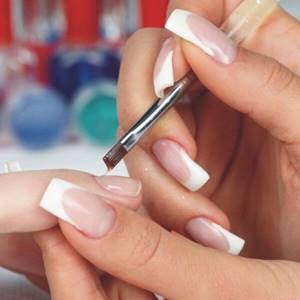
There is a myth that it is healthy and more environmentally friendly, since it is based on mulberry resin. This is a popular misconception. Biogel is a polymer, the same as acrylic and gel.
Biogel is odorless, non-toxic, suitable for extensions for pregnant women. Masters work with it mainly for short length extensions, for strengthening and leveling the plate after regular extensions, for brittle nails, instead of a base for gel polish or instead of gel polish in general. Biogel is used for biolamination and sealing of ends.
Biogel can be applied without primer and base. Polymerizes in a lamp for an average of 2 minutes. Can be applied to lower forms, used with tips and liquid tips. Removed with a special liquid.
pros
- Safety, environmental friendliness, suitable for pregnant women
- Easy to use
- Possibility of aesthetic correction of thin, brittle and overdried nail plates
- Easily removed with a special liquid
Minuses
- Used with a drying lamp, you will need one
- It is impossible to grow long nails due to the increased flexibility of the material
Biogel and its properties for strengthening, building, health and growth of nails
How to do nail extensions: tips for beginners
To make the result pleasing for a long time, use the advice of nail experts.
The use of base and top is mandatory. They serve as a protective layer and are necessary to increase the wear time of the manicure.
If you have no experience in cutting the cuticle, then you can leave it alone. To make your nails beautiful, first treat the cuticles with a special solution, and then push them back with an orange stick.
Moisturize your cuticles and the skin around your nails with oils daily. This will improve the condition of the skin, make the manicure and hands more attractive in general.
When choosing your nail shape, consider the length of your fingers. If they are long, then choose a square. Almonds and soft squares are suitable for medium and short fingers.
If the plate is uneven, you can distract attention from it by using a bright camouflage varnish.
You can avoid peeling when processing your nails by working with a nail file in one direction.
Two coats of camouflage polish will last longer than one coat.
How to do nail extensions at home - take free courses from nail technicians, subscribe to their pages on social networks, study the material. You will have to spend a lot of time on this, but there is enough content to do a manicure just for yourself. If you are planning to do eyelash extensions at home and nail extensions for strangers, then it is better to take specialized courses and receive a diploma after graduation.
Common mistakes when building hair extensions
Before you do nail extensions at home, you should familiarize yourself with the common mistakes of beginners in the nail industry.
- The material does not dry out. This happens in situations where a too thick layer of varnish is applied and listened to in low-power lamps. To prevent this mistake, you need to apply thin layers of varnish and dry them in suitable lamps.
- The form is placed incorrectly. This results in too little material near the side ridges, which causes nail breakage.
- Incorrect nail architecture. Another reason for broken nails. If the architecture is not built correctly, the load on the apex increases, which leads to rapid breakage of the free edge of the nail.
- Allergy. The use of low-quality materials and individual intolerance to the components leads to a negative reaction in the form of a rash, pain, and detachment of the material.
- Fungus. Occurs during the correction of extended nails when air pockets have not been eliminated.
- Unsealed end and material flowing onto the skin. Two reasons for the material to peel off from a natural nail.
When doing nail extensions at home, you need to learn how to apply the material with a middle layer. A layer that is too thin risks cracking, and a thick layer risks breaking natural nails as they grow.
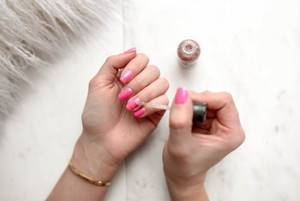
Benefits of the procedure
Nail extension with fabric has a number of advantages, thanks to which it can be used as an independent method of nail extension. The main advantages of the technique include the following points.
- Nails extended using the fabric method are quite impact-resistant and elastic.
- It is very easy to repair a damaged nail - a new layer of tissue is simply attached to the crack.
- The procedure can be carried out using various fabrics - extensions with fiberglass, linen, silk, depending on the client’s wishes.
- Thanks to the presence of a variety of colors and textures of fabrics, you can get different designs on your nails, which allows you to eliminate the need to constantly use a coating.
- Nail extensions using fabric covering are as hypoallergenic as possible and are almost incapable of causing an allergic reaction.
Nail extensions with fabric allow you to extend nails of various shapes and lengths with flax, silk or fiberglass (fabric that looks like silk and is made from fiberglass). The principle of the technique lies in the fact that a tip (plastic nail) is glued onto your own nails, onto which layers of fabric are glued.




